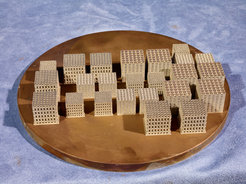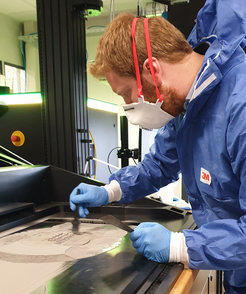Printed: Tungsten grids
Complex tungsten structures from 3D printer / test samples for demonstration power plant
A 3D printing process was used by a team headed by Alexander von Müller from Max Planck Institute for Plasma Physics (IPP) in Garching to produce complex components of tungsten, the metal with the highest melting point.

Tungsten test pieces produced with a 3D printing process. The fine grid architecture is intended to give the heat-resistant tungsten low thermal conductivity.
“Filigree tungsten objects cannot be produced by conventional methods such as milling from a metal block or pressing and sintering of metal powder”, says Alexander von Müller. “This left us with the relatively new method of additive manufacturing, also known as 3D printing”.
In the course of his doctoral thesis, he had already gained experience with processing of tungsten and had also used 3D printing methods – albeit for a different purpose. This made him the right contact for Italian researchers at the Universities of Tuscia in Viterbo and Tor Vergata in Rome, who are developing components for a future fusion demonstration power plant. They had calculated lattice structures from robust tungsten to shield certain areas of the vessel wall from short, intense heat pulses from the hot plasma. In contrast to solid tungsten plates, the grids are characterized by lower thermal conductivity and are intended to ensure that the wall sections behind them are not thermally overloaded.

The manufacturing process was developed in cooperation with the Fraunhofer Research Institution for Casting, Composite and Processing Technology (IGCV) in Augsburg, which provided the equipment for 3D printing: A computer-controlled laser beam melts tungsten powder layer by layer into the pattern of the desired grid structure, so that the complex component builds up layer by layer. This was preceded by a longer development period during which the parameters that determine the manufacturing process had to be clarified, such as the grain size of the tungsten powder or the power of the laser beam.
In the meantime, the scientists have shown that they can produce the necessary test samples. The next step is to find out whether they actually have the properties required to withstand a plasma load.

